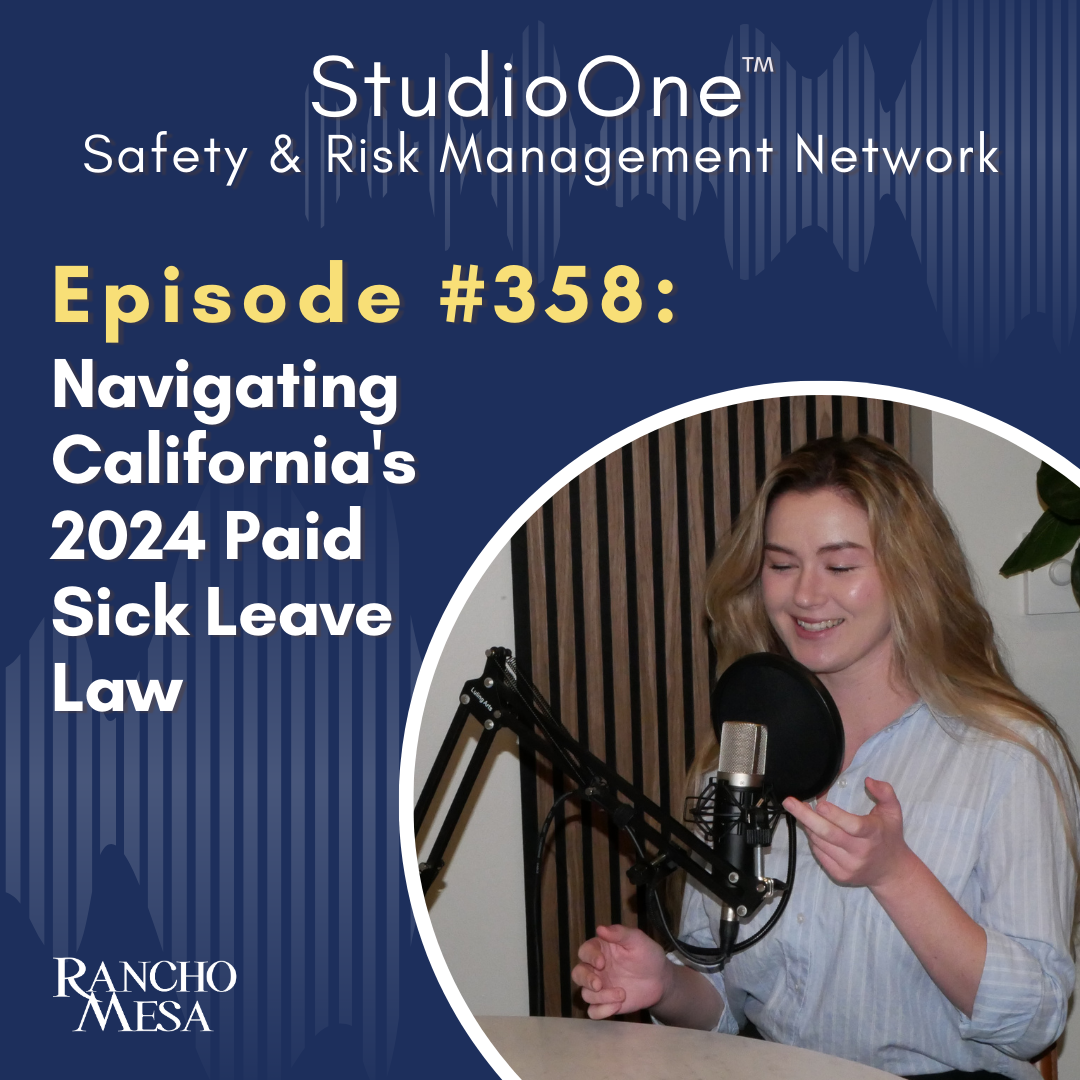Ep. 358 Navigating California's 2024 Paid Sick Leave Law: What Employers Need to Know
Rancho Mesa's Alyssa Burley and Client Communications Coordinator Megan Lockhart delve into the upcoming changes to California's paid sick leave law in 2024. They discuss the new requirements for employers, whether to use the accrual or lump sum method, and provide insights on how companies can prepare for these significant legal changes. Tune in to get a better understanding of the evolving landscape of paid sick leave in California, and ensure your compliant with the upcoming regulations.
Show Notes: Subscribe to Rancho Mesa's Newsletter. www.RanchoMesa.com/workshops-and-webinars
Director/Host: Alyssa Burley
Guest: Megan Lockhart
Producer/Editor: Lauren Stumpf
Music: "Home" by JHS Pedals, “News Room News” by Spence
© Copyright 2023. Rancho Mesa Insurance Services, Inc. All rights reserved.
Transcript
Alyssa Burley: Hi. This is Alyssa Burley with Rancho Mesa Media Communications and Client Services Department. Thank you for listening to today's top Rancho Mesa News, brought to you by our Safety and Risk Management Network StudioOne. Welcome back, everyone. My guest is Megan Lockhart, Client Communications Coordinator with Rancho Mesa. Today, we're going to talk about the new paid sick leave law going into effect January 1st, 2024, which increases the amount of required paid sick leave for employees in California. Megan, welcome to the show.
Megan Lockhart: Thanks for having me, Alyssa.
AB: Of course. So these new standards for paid sick leave were approved by Governor Newsom earlier this month. Now, there are a lot of details involved in this new law. Can you first tell us the basics so we can get an understanding of what's being required?
ML: Yeah, so effective January 1st of 2024 the amount of paid sick leave employers must provide, their employees in California will increase from 24 hours or three days to 40 hours or five days per year. The details of how companies will need to make adjustments to this increased paid sick leave depends on their methods of offering employee leave time. So they could use the accrual method of gaining leave hours over a period of time, or the lump sum method which allots a sum of paid sick leave hours to employees each year on a specific date.
AB: All right. So will you break down the new requirements for employees who accrue sick hours over a period of time?
ML: Yes. Employers who provide leave through an accrual system must allow employees to accrue at least 24 hours of paid sick leave by their 120th day of employment and the remainder of the 40 hours by their 200th day of employment.
AB: Okay, so that makes sense. If an employer is using the accrual method. Are there guidelines for how many hours must be accrued over a certain period of time?
ML: So the accrual method normally follows a rate of one hour of paid sick leave per every 30 hours worked. But employers can choose how time is earned as long as it meets the new standards. So hitting 24 hours by the 120th day and 40 hours by the 200th.
AB: Okay. So as long as the 24 hours of paid sick time accrues by the 120th day and the rest of the 40 hours by the 200th day, it really doesn't matter if it's done by hours, worked weeks on the job or any other calculation. So what about the lump sum method? Is that similar to this?
ML: So it is similar. Companies that operate by offering a lump sum of hours at one time just need to grant the sum of 24 hours of paid sick leave to employees by no later than their 120th day of employment. And they must allot them the rest of the leave, so the additional 60 hours, by the 200th day of employment. Employers can, however, choose to just give employees all 40 hours at the beginning. The only differences are that if a company breaks up the leave allotment into these 120 and 200 day increments, they must allow carryover of any unused leave. But if they provide the entire 40 hours at the start of the employment or calendar year, they don't need to allow for carryover. They can just start fresh by granting those 40 hours again when the year cycle refreshes.
AB: Okay. Well, that is some really important information regarding this upcoming law. So how can companies prepare for when this actually takes effect and it's only just a couple of months?
ML: Yeah! So to prepare, employers should evaluate their current paid sick leave policies and make necessary changes to ensure they stay in compliance. And we have resources in the RM365 HRAdvantage Portal™. And, you know, we have our highly anticipated 2024 Employment Law Update Webinar on Wednesday, November 8th, that will cover this law in finer detail, and many other laws that employers should be aware of taking effect next year. And it's hosted by Thomas E Doherty from Klinedinst Attorneys.
AB: All right, great. And we'll include a link to register for that webinar in the episode notes. Megan, thank you for joining me in StudioOne.
ML: Of course, thanks Alyssa.
AB: This is Alyssa Burley with Rancho Mesa. Thanks for tuning in to our latest episode produced by StudioOne. For more information, visit us at ranchomesa.com, and subscribe to our weekly newsletter.

